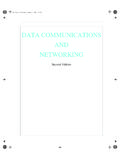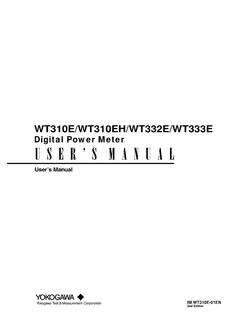Transcription of CHAPTER 8: NETWORKING AND DIGITAL COMMUNICATION
1 Copyright 2008 Prentice-Hall. All rights reserved. CHAPTER 8: NETWORKING AND DIGITAL COMMUNICATION Multiple Choice: 1. A basic computer network can be described as: A. a minimum of five computers linked together. B. a number of palmtop computers. C. two or more computers that are linked together. D. the use of satellites linking computers together. Answer: C Reference: Basic Network Anatomy Difficulty: Easy 2. The three essential components of every computer system include all of the following EXCEPT: A. software. B. hardware. C. people. D. cables. Answer: D Reference: Basic Network Anatomy Difficulty: Easy 3. All of the following are advantages of using a computer network EXCEPT that it: A. reduces costs when hardware is shared. B. promotes independence so users have exclusive control over their own data and applications. C. saves money when software is shared. D. enables data sharing, increasing efficiency and productivity.
2 Answer: B Reference: Basic Network Anatomy Difficulty: Easy CHAPTER 8: NETWORKING and DIGITAL COMMUNICATION Copyright 2008 Prentice-Hall. All rights reserved. 2 4. All of the following statements are true EXCEPT: A. Wireless networks are convenient. B. Wireless networks are generally slower than wired LANs. C. Wireless networks use radio transmitters. D. Wireless networks are generally faster than wired networks. Answer: D Reference: Networks Near and Far Difficulty: Moderate 5. A(n) _____ broadcasts messages to all devices connected to a LAN. A. switch B. port C. hub D. node Answer: C Reference: Networks Near and Far Difficulty: Moderate 6. In a local area network, a _____ only transmits data to the destination node. A. switch B. port C. hub D. router Answer: A Reference: Networks Near and Far Difficulty: Moderate 7. LAN stands for: A. local area nodes. B.
3 Logical arrangement of networks. C. local area network. D. linked-area network. Answer: C Reference: Networks Near and Far Difficulty: Easy CHAPTER 8: NETWORKING and DIGITAL COMMUNICATION Copyright 2008 Prentice-Hall. All rights reserved. 3 8. The primary difference between a LAN and a WAN is the: A. number of software programs available. B. geographical area. C. variety of hardware devices. D. number of hardware devices. Answer: B Reference: Networks Near and Far Difficulty: Moderate 9. Each individual computer and networked peripheral attached to a LAN is a: A. node. B. GPS receiver. C. router. D. mesh network. Answer: A Reference: Networks Near and Far Difficulty: Easy 10. Standard telephone cables containing copper wires are known as _____ cable. A. coaxial B. fiber-optic C. Wi-Fi D. twisted pair Answer: D Reference: Networks Near and Far Difficulty: Moderate 11.
4 All of the following are true of a wireless network EXCEPT: A. computers at the nodes can run different operating systems. B. generally faster than wired LAN. C. less trouble to install. D. convenient for users that work in many locations. Answer: B Reference: Networks Near and Far Difficulty: Moderate CHAPTER 8: NETWORKING and DIGITAL COMMUNICATION Copyright 2008 Prentice-Hall. All rights reserved. 4 12. MAN stands for: A. metropolitan area network. B. multifunction area network. C. metropolitan arranged network. D. manufactured arrangement of networks. Answer: A Reference: Networks Near and Far Difficulty: Easy 13. The collection of common pathways between networks on a WAN is known as a: A. node. B. hub. C. backbone. D. router. Answer: C Reference: Networks Near and Far Difficulty: Challenging 14. The device or program that forwards messages between networks is known as a: A.
5 Bridge. B. router. C. backbone. D. gateway. Answer: B Reference: Networks Near and Far Difficulty: Moderate 15. A(n) _____ is often used to set up a temporary communications system that requires no centralized router. A. extranet B. Ethernet C. mesh network D. intranet Answer: C Reference: Networks Near and Far Difficulty: Moderate CHAPTER 8: NETWORKING and DIGITAL COMMUNICATION Copyright 2008 Prentice-Hall. All rights reserved. 5 16. The Department of Defense uses a(n) _____, which is a specialized network used to determine locations, maps, and directions using signals from satellites that are orbiting the Earth. A. mesh network B. NIC C. Ethernet D. GPS Answer: D Reference: Specialized Networks: From GPS to Financial Systems Difficulty: Easy 17. The system of satellites used to determine any position on the Earth is known as: A. GPS. B. LAN. C. Wi-Fi.
6 D. MAN. Answer: A Reference: Specialized Networks: From GPS to Financial Systems Difficulty: Easy 18. A set of parallel wires that carries DIGITAL signals among a computer s components is called a(n): A. peripheral. B. port. C. bus. D. medium. Answer: C Reference: The Network Interface Difficulty: Moderate 19. In the 1970s, Xerox developed _____, which continues to be a popular NETWORKING architecture. A. Wi-Fi B. instant messaging C. extranet D. Ethernet Answer: D Reference: The Network Interface Difficulty: Moderate CHAPTER 8: NETWORKING and DIGITAL COMMUNICATION Copyright 2008 Prentice-Hall. All rights reserved. 6 20. Remote access means that a: A. computer is linked directly to a network. B. transaction is added to a batch that will be processed on a remote computer. C. user is connecting to a network through a phone line, television cable, or wireless link. D. LAN is set up in an office in a remote location.
7 Answer: C Reference: The Network Interface Difficulty: Easy 21. A port is a: A. socket that enables information to move in and out. B. hardware device that allows connection to the Internet. C. peripheral device attached to a computer. D. virtual memory location. Answer: A Reference: The Network Interface Difficulty: Easy 22. A newer PC will likely have an Ethernet _____ on the main circuit board so it can directly connect to an Ethernet network. A. router B. network interface card C. port D. jack Answer: C Reference: The Network Interface Difficulty: Moderate 23. A(n) _____ port is faster and more flexible than a traditional serial or parallel port. A. peripheral B. USB C. monitor D. server Answer: B Reference: The Network Interface Difficulty: Moderate CHAPTER 8: NETWORKING and DIGITAL COMMUNICATION Copyright 2008 Prentice-Hall. All rights reserved. 7 24.
8 NIC stands for: A. network internal card. B. newer industrial computer. C. NETWORKING Internet connection. D. network interface card. Answer: D Reference: The Network Interface Difficulty: Moderate 25. A(n) _____ adds a special serial port to a computer so it can be directly connected to a network. A. GPS B. NIC C. modem D. hub Answer: B Reference: The Network Interface Difficulty: Easy 26. The NIC controls the flow of data between the computer s RAM and the: A. network cable. B. Internet. C. hard drive. D. CD drive. Answer: A Reference: The Network Interface Difficulty: Easy 27. A(n) _____ signal is represented by a continuous wave. A. analog B. DIGITAL C. bandwidth D. baud Answer: A Reference: COMMUNICATION la Modem Difficulty: Moderate CHAPTER 8: NETWORKING and DIGITAL COMMUNICATION Copyright 2008 Prentice-Hall. All rights reserved. 8 28. A(n) _____ converts a message from DIGITAL to analog or from analog to DIGITAL .
9 A. hub B. modem C. switch D. Ethernet Answer: B Reference: COMMUNICATION la Modem Difficulty: Easy 29. A voice message must be converted to a(n) _____ signal so it can be stored on a computer s hard drive. A. Wi-Fi B. bitmapped C. DIGITAL D. analog Answer: C Reference: COMMUNICATION la Modem Difficulty: Moderate 30. _____ is defined as millions of bits. A. Megabytes B. Megabits C. Kilobits D. Kilobytes Answer: B Reference: Broadband Connections Difficulty: Moderate 31. The term, _____, refers to the amount of information transmitted through a COMMUNICATION medium in a given amount of time. A. dpi B. bit depth C. bandwidth D. broadband Answer: C Reference: Broadband Connections Difficulty: Moderate CHAPTER 8: NETWORKING and DIGITAL COMMUNICATION Copyright 2008 Prentice-Hall. All rights reserved. 9 32. A Broadband connection could be any of the following EXCEPT: A.
10 Cable modem. B. DSL. C. wireless connection. D. standard phone modem. Answer: D Reference: Broadband Connections Difficulty: Easy 33. A(n) _____ cable uses light waves to transmit multimedia and voice data. A. copper B. twisted-pair C. fiber-optic D. coaxial Answer: C Reference: Fiber-Optic Connections Difficulty: Easy 34. A(n) _____ uses radio waves to carry information at high speed. A. cable modem B. fiber-optic cable C. wireless connection D. phone cable Answer: C Reference: Wireless Network Technology Difficulty: Moderate 35. A personal area network is possible because of the wireless technology known as: A. USB. B. FireWire. C. Bluetooth. D. IEEE. Answer: C Reference: Wireless Network Technology Difficulty: Moderate CHAPTER 8: NETWORKING and DIGITAL COMMUNICATION Copyright 2008 Prentice-Hall. All rights reserved. 10 36. _____ is new technology currently available in Japan, much of Europe, and some major US cities.





